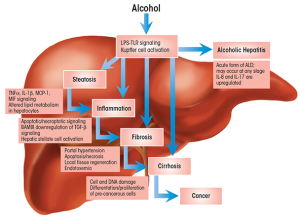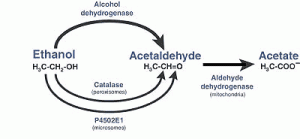ARTICLE OVERVIEW: Heavy drinking can result in serious alcoholic liver diseases including cirrhosis, hepatitis, fatty liver, and even cancer. But, liver damage can be reversed. How? We review here. If you have additional questions, feel free to post them in the comments section at the end.
TABLE OF CONTENTS:
- What is Liver Damage?
- Risk Factors
- Metabolism
- How Alcohol Affects the Liver
- Alcohol and Cancer
- Alcohol and Cirrhosis
- Symptoms of Liver Disease
- Can the Damage Be Reversed?
- Treatment for Alcoholism
What is Liver Damage?
The meaty, reddish-brown organ known as the liver has a huge role in filtering the blood, and is active in digestion, absorption, and the processing of food. Moreover, it detoxifies chemicals or toxins that make their way into our bodies, and metabolizes drugs. How does alcohol cause liver damage?
Alcohol stays in the bloodstream until it is metabolized by the liver, during which it can do much harm to this organ.
Let’s explain the process a little more clearly. The liver can metabolize a certain amount of alcohol at any given time, But if you drink excessively, chronically, or too quickly, your liver cells struggle to process it. This can result in developing serious alcoholic liver diseases such as:
- Alcoholic hepatitis
- Cirrhosis
- Fatty liver
Alcohol liver disease is the development of liver damage as a result of heavy drinking.
Risk Factors
According to the Centers for Disease Control and Prevention there are 4.9 million adults diagnosed with liver disease, while just over 21K people died from alcoholic liver disease. [1] So, who is at risk of developing liver disease?
Typically, most heavy drinkers develop serious alcoholic liver disease. This is why alcohol consumption accounts for approximately 3.8% of all global deaths and 4.6% of global disability-adjusted life-years. [2] Further, people who drink excessively are at a higher risk of developing an alcoholic liver disease. Those who do not follow the guidelines on standard drinking are directly exposed to liver diseases, which may have a fatal outcome. [3]
MedlinePlus reports that liver trouble is common in people between 40 and 50 years old, and men are more likely than women to develop liver disease. [4] Keep in mind that women are not immune to alcoholic liver disease. In fact, they can develop this condition after less exposure to alcohol than men.
Metabolism
The liver is a filter of the human body: it breaks down and gets rid of harmful substances in the body. The liver further transforms vitamins, nutrients, and medicines into substances needed by the body. So, just how is alcohol metabolized in the liver? [5]
90% of alcohol is metabolized in the liver by oxidation via action of the enzyme called “alcohol dehydrogenase (ADH)”, while less than 10% is eliminated in breath, sweat, and urine. Alcohol is absorbed into the system more rapidly than it is metabolized, and this is the reason why alcohol levels build up in the body. In fact, one unit of alcohol stays in the body up to 2 hours after being consumed. This time frame increases with each drink. The higher the blood alcohol concentration, the longer it takes to process alcohol. [6]
How Alcohol Affects the Liver
But the liver can only process a certain amount of alcohol at a time. So, when someone drinks too much, the alcohol that is unprocessed circulates through the bloodstream.
Q: How much alcohol does it take to damage the liver?
A: The amount of damage that alcohol causes depends on the drinker and individual factors.
Experts know that heavy drinking (as well as chronic drinking) destroys liver cells, causing serious damages such as cirrhosis, alcoholic hepatitis, and the cellular mutation that leads to liver cancer. So, the American College of Gastroenterology has set out guidelines that state: “Prolonged abstinence is the most effective strategy to prevent disease progression.” [7]
Alcohol and Cancer
Can alcohol cause liver cancer?
YES!
Drinking too much alcohol regularly can damage the liver, leading to scarring and inflammation, which also raises the risk of developing liver cancer. According to this NIAAA’s synopsis on alcohol liver diseases, people with alcohol-related cirrhosis are at much higher risk for development of liver cancer. [8]
Hepatocellular carcinoma (liver cancer) is the eighth most frequent cancer worldwide, accounting for approximately 500,000 deaths annually. [9]
How does alcohol cause liver cancer?
Alcohol is converted in our bodies into the toxic chemical, acetaldehyde. This toxin can cause cancer by damaging DNA and stopping cells from repairing liver damage. Also, it makes liver cells grow faster than usual, and these cells are more likely to pick up changes in their genes. [10] This is why the International Agency for Research for Cancer has classified acetaldehyde together with alcohol use as carcinogenic for people. [11]
However, scientists are still limited in their understanding. Even though there is much plausible evidence, the mechanisms about how alcohol causes carcinogenic effect have not been defined in depth.
Alcohol and Cirrhosis
One of the most serious alcohol liver diseases is cirrhosis. This disease replaces normal liver tissue with scar tissue, disrupting blood flow, and preventing the liver from working properly.
Signs of cirrhosis include:
- Abnormal accumulation of fat in normal liver cells.
- Liver enlargement or inflammation.
- Redness of the palms caused by capillary dilation.
- Shortening of muscles in the fingers caused by toxic effects or fibrous changes.
- Thickening and widening of the fingers and nails.
- White nails.
Why does alcohol cause liver cirrhosis?
Currently, there are no empirical studies that adequately explain why and how alcohol consumption causes cirrhosis. Regardless, the correlation between drinking and this disease is strong. Our federal institute of health reports that between 40% to 90% of the 26,000 annual deaths from cirrhosis are alcohol-related. [12]
Even further, the National Institute on Alcohol Abuse and Alcoholism (NIAAA) reports that about 10% to 15% of people diagnosed with alcohol use disorder develop cirrhosis, and many are unaware that they have it. In fact, about 30%-40% of the cases with cirrhosis are diagnosed at autopsy. Moreover, the NIAAA states that 5-year survival rate of people with cirrhosis is about 90% for those who stopped drinking, while it is 70% of those who didn’t stop drinking. [8]
Symptoms of Liver Disease
Some common early symptoms of liver disease include:
- Abdominal pain.
- Appetite loss, and weight loss
- Energy loss.
- Small, red spider-like blood vessels on the skin.
As the function of the liver worsens, more serious symptoms take place:
- Abdomen swelling.
- Dark urine.
- Discolored stool.
- Confusion and problem thinking.
- Itchy skin.
- Fatigue.
- Leg swelling.
- Nausea and/or vomiting.
- Readiness on the palms.
- Unusual bruising.
- Yellowish skin and eyes.
Diagnosis of alcoholic liver disease is made with biopsies, but laboratory tests can help too. If you notice any of these symptoms, consult with a physician ASAP.
Can the Damage Be Reversed?
The only organ in the body that has the ability to regenerate its damaged tissue with new cells is the liver. So, most people want to know, “Can alcoholic liver damage be reversed?”
Yes, liver damage can be reversible… if you stop drinking.
One study on alcohol-related cirrhosis found that alcohol abstinence is a key factor in the survival rate, even in the most severe cases. Its findings show that abstinence from alcohol at one month after diagnosis of cirrhosis was one of the most important factors determining survival: 7-year survival of 72% of people who stopped drinking in comparison with 44% of people who continue to drink. [13]
However, the liver may get overwhelmed, and it can lose the function to repair itself completely. This usually happens if it is still “under attack” from drug use, continued drinking, or a virus. In these cases, a scar tissue develops, which becomes difficult to reverse.
Lifestyle changes can support the liver more than you think. You can start taking care of yourself (and your liver) with these simple life changes:
- Stop drinking.
- Eat a healthy diet low in salt.
- Consult regularly with a healthcare provider.
While there is no safe amount of alcohol beverage to consume, many reputable sources report that if you drink in moderation (one drink per day for women, and two for men) you will do less harm to the liver. But, liver disease due to alcohol consummation is avoidable. Why drink, and put yourself at risk, when you can do more for your health?
The best way to take care of your liver is to stop drinking.
Treatment for Alcoholism
If you are struggling with liver disease, alcohol addiction can be treated. In these cases, it is important to find evidence-based treatment for alcoholism. There are two main types of alcohol rehab programs: inpatient and outpatient. [14]
Inpatient treatment provides constant medial care and supervision because patients live at the facility. This type of treatment is designed to help people with moderate to severe addictions. Some of the services include:
- Detox services.
- Educational classes.
- Group therapy.
- Individual therapy.
- Medication and medical support.
Outpatient treatment provides similar services, but patients do not live at the facility. They visit the rehab center for few hours at day, several days weekly. This treatment is designed for people who are willing to change, have mild cases of addiction, and have emotional support from loved ones at home.
If you have drinking problems, don’t wait. Seek help as soon as possible. We can help, you only need to reach out. Feel free to leave us a question at the end…or give us a call.












Related Posts